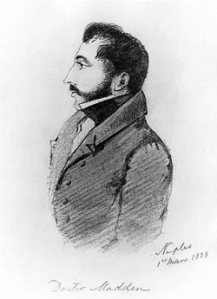Richard Robert Madden (1798-1886) and David Turnbull (1793?-1851)
I’ve been digging through the Oxford Dictionary of National Biography and found Richard Robert Madden and David Turnbull. Here’s a synopsis:
Richard Robert Madden (1798-1886), born in Dublin, practiced as a surgeon on Curzon Street in the Mayfair district of London until he was appointed to Jamaica in 1833 to mediate the transition from slavery to apprenticeship, of which he was an adamant proponent. After resigning in 1834 because of conflicts with plantation owners, he published A twelve-month’s residence in the West Indies during the transition from slavery to apprenticeship (1835), a two-volume record of his experiences primarily in Jamaica but also on other islands. He took up an appointment in Havana, Cuba in 1836 as “superintendent of the liberated Africans and judge arbitrator in the mixed court of commission.” While in Cuba, he wrote extensively on slavery, and in 1840 he published Address on Slavery in Cuba, Presented to the General Anti-Slavery Convention and left Cuba. He then went on to Egypt, West Africa, Lisbon, and Western Australia before returning to Ireland in 1848, when he advocated for the Irish peasantry during the potato blight. Madden’s interest in Ireland is reflected in publications such as The United Irishmen, their Lives and Times, A History of Irish Periodical Literature from the End of the Seventeenth to the Middle of the Nineteenth Century, and Literary Remains of the United Irishmen of 1798. He is buried in Donnybrook Cemetery in Dublin.
There’s more to his story that I’ll leave you to discover, but Madden’s experiences are strikingly similar to those of Roger Casement, who was born in County Antrim just a few years before Madden’s death. The black diaries are supposed to offer some connection between Casement and the Caribbean, although I need to look into that. There’s also someone else to look into: David Turnbull (1793?-1851), who married Elinor Casement of the Casement family in Antrim. Turnbull was a Scotsman, possibly born in Glasgow, who worked as a news correspondent as well as joined the English Anti-Slavery Society. He traveled to Demerara, Barbados, Trinidad, Jamaica, Port au Prince, and Cuba and he published Travels in the West in 1840. Turnbull then replaced Madden in Havana as superintendent. Things in Cuba didn’t go well for him, as he was too adamant an abolitionist it seems, and he was eventually expelled in 1842 from Cuba shortly after moving to New Providence, Nassau, Jamaica. While in Jamaica, he continued his anti-slavery work and published The Jamaica Movement for the Promoting of Slave-Trade Treaties in 1850. He died in Paris in 1851.
For more on Madden, visit this blog post.
Original sources for this post: please see bibliographic resources page for Manuel Llorca-Jaña and J.M. Rigg.

For an excellent article on Madden see our own Fionnghuala Sweeney’s “‘To Redeem Our Colonial Character’: Slavery and Civilization in R. R. Madden’s A Twelvemonth’s Residence in the West Indies” in O’Neill and Lloyd’s The Black and Green Atlantic: Crosscurrents of the Irish and African Diasporas. Basingstoke: Palgrave, 2009
Yes, and Nini Rodgers’ “Richard Robert Madden: An Irish Anti-Slavery Activist in the Americas” in Ireland Abroad: Politics and Professions in the Nineteenth Century (Ed. Oonagh Walsh, 2002, Four Courts Press).